Harrow Hospital
Roxeth Hill, Harrow, Middlesex, HA2 0JX
Medical dates:
Medical character:
Acute. Later, geriatric
The Harrow Cottage Hospital was founded in 1866 by Dr. W. Hewlett. It had nine beds and occupied two
leased cottages in Roxeth Hill. The staff consisted of a paid nurse and a voluntary team of helpers.
In 1868 the landlady gave notice to quit and a local benefactor, Charles Leaf, offered a piece of land in Lower Road, provided that the money could be found for a new hospital building (in the event he bore most of the expenses of the new building). Fund-raising began immediately and, in 1872, the Hospital moved to its new premises, where it had 11 beds, an operating theatre and a dispensary, as well as two rooms for the resident staff. The opening day was marked by the wettest weather of one of the wettest seasons experienced.
The Hospital resembled a large private house with small and inconvenient wards on several floors. The staircase soon proved to be too narrow and steep to be able to move bed-ridden patients easily. A few days before its official opening, the Lady Manager, Constance Hewlett, discovered the builders had failed to provide a wash house. She converted the intended mortuary to a laundry, and the coal house became the new mortuary.
In fact, patients were responsible for their own laundry, and were also expected to help with the housework, needlework, gardening and similar chores. They were also only allowed to read publications sanctioned by the Vicar of Harrow.
In 1885 the inadvertent admission of a patient with smallpox meant that an entire ward had to be repainted and white-washed, and its bedding and furniture renewed, thus stressing the Hospital's precarious financial situation even more. It was decided that a separate isolation hospital should be built. (This opened as the Harrow Isolation Hospital in 1894.)
In 1895 the weekly cost of an in-patient was £1 6s 10d (£1.34). Patients belonging to the 'labouring classes' were expected to contribute 9d (4p) a day towards their keep, while shopkeepers and mechanics were charged 1s (5p) a day. Domestic servants, however, were charged more, presumably because their employers paid for their stay in hospital.
In 1897 some 65 in-patients were treated at the Hospital.
Plans were made for a larger general hospital. The chosen architect was Arnold Mitchell, who had designed the Orley Farm School. In 1905 3.5 acres of land in Roxeth Hill were purchased and the new Hospital building, with 18 beds, opened in 1907. It was staffed by a Matron and four nurses. By 1910 it had an annual expenditure of £799.
During WW1 the Hospital was affiliated with the Bethnal Green Military Hospital, with 20 of its beds reserved for sick and wounded servicemen.
In 1924 it was renamed Harrow Hospital. Extensions to the building were added the following year.
In 1931 its name changed to the Harrow and Wealdstone Hospital. In 1932 the Duchess of York (later Queen Elizabeth, the Queen Mother) opened a major extension. In 1933 a Training School for nurses was established, and the old Roxeth Vicarage, adjacent to the Hospital, was acquired for student accommodation. By 1935,the Hospital had 80 beds and the Matron was in charge of 30 nurses.
In 1945 it was renamed Harrow Hospital again. In 1948 it joined the NHS under the control of the Charing Cross Hospital Management Committee, part of the London (Teaching) Regional Hospital Board.
In 1966 it had 121 beds. Further buildings had been added to the site, including the Edith Martin Memorial Hall, in memory of a highly regarded Matron who had died in 1963.
In 1974, following a major NHS reorganisation, the Hospital became part of the Harrow District Health Authority, part of the North West Thames Regional Health Authority.
By 1984, the bed number had been reduced to 55.
The Hospital, with 53 beds for care of the elderly, finally closed in 1998
Present status (May 2008)
Once described as the 'prettiest cottage hospital in the country', the original building in Roxeth Hill is Grade II listed. The former Hospital is now part of the gated estate 'The Grange' in Cottage Close, set in mature landscaped gardens.
Barratt Homes redeveloped the site in 2006, converting the existing Hospital buildings into 20 luxury apartments. Five townhouses and apartment blocks for 71 dwellings were also built on the site.
The Sidney Walton Nurses Home was redeveloped by the nearby Christ Church and the Ealing YMCA into an independently accessed hostel containing 42 one-bedroom units.
In 1868 the landlady gave notice to quit and a local benefactor, Charles Leaf, offered a piece of land in Lower Road, provided that the money could be found for a new hospital building (in the event he bore most of the expenses of the new building). Fund-raising began immediately and, in 1872, the Hospital moved to its new premises, where it had 11 beds, an operating theatre and a dispensary, as well as two rooms for the resident staff. The opening day was marked by the wettest weather of one of the wettest seasons experienced.
The Hospital resembled a large private house with small and inconvenient wards on several floors. The staircase soon proved to be too narrow and steep to be able to move bed-ridden patients easily. A few days before its official opening, the Lady Manager, Constance Hewlett, discovered the builders had failed to provide a wash house. She converted the intended mortuary to a laundry, and the coal house became the new mortuary.
In fact, patients were responsible for their own laundry, and were also expected to help with the housework, needlework, gardening and similar chores. They were also only allowed to read publications sanctioned by the Vicar of Harrow.
In 1885 the inadvertent admission of a patient with smallpox meant that an entire ward had to be repainted and white-washed, and its bedding and furniture renewed, thus stressing the Hospital's precarious financial situation even more. It was decided that a separate isolation hospital should be built. (This opened as the Harrow Isolation Hospital in 1894.)
In 1895 the weekly cost of an in-patient was £1 6s 10d (£1.34). Patients belonging to the 'labouring classes' were expected to contribute 9d (4p) a day towards their keep, while shopkeepers and mechanics were charged 1s (5p) a day. Domestic servants, however, were charged more, presumably because their employers paid for their stay in hospital.
In 1897 some 65 in-patients were treated at the Hospital.
Plans were made for a larger general hospital. The chosen architect was Arnold Mitchell, who had designed the Orley Farm School. In 1905 3.5 acres of land in Roxeth Hill were purchased and the new Hospital building, with 18 beds, opened in 1907. It was staffed by a Matron and four nurses. By 1910 it had an annual expenditure of £799.
During WW1 the Hospital was affiliated with the Bethnal Green Military Hospital, with 20 of its beds reserved for sick and wounded servicemen.
In 1924 it was renamed Harrow Hospital. Extensions to the building were added the following year.
In 1931 its name changed to the Harrow and Wealdstone Hospital. In 1932 the Duchess of York (later Queen Elizabeth, the Queen Mother) opened a major extension. In 1933 a Training School for nurses was established, and the old Roxeth Vicarage, adjacent to the Hospital, was acquired for student accommodation. By 1935,the Hospital had 80 beds and the Matron was in charge of 30 nurses.
In 1945 it was renamed Harrow Hospital again. In 1948 it joined the NHS under the control of the Charing Cross Hospital Management Committee, part of the London (Teaching) Regional Hospital Board.
In 1966 it had 121 beds. Further buildings had been added to the site, including the Edith Martin Memorial Hall, in memory of a highly regarded Matron who had died in 1963.
In 1974, following a major NHS reorganisation, the Hospital became part of the Harrow District Health Authority, part of the North West Thames Regional Health Authority.
By 1984, the bed number had been reduced to 55.
The Hospital, with 53 beds for care of the elderly, finally closed in 1998
Present status (May 2008)
Once described as the 'prettiest cottage hospital in the country', the original building in Roxeth Hill is Grade II listed. The former Hospital is now part of the gated estate 'The Grange' in Cottage Close, set in mature landscaped gardens.
Barratt Homes redeveloped the site in 2006, converting the existing Hospital buildings into 20 luxury apartments. Five townhouses and apartment blocks for 71 dwellings were also built on the site.
The Sidney Walton Nurses Home was redeveloped by the nearby Christ Church and the Ealing YMCA into an independently accessed hostel containing 42 one-bedroom units.
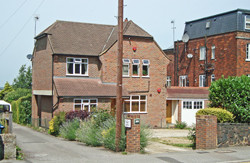
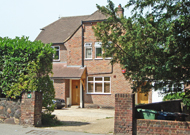
The Hospital building at 14 Lower Road became a private house named The Retreat. It was destroyed by bombs during WW2 and a new house now occupies the site.
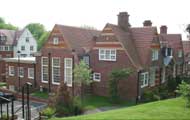
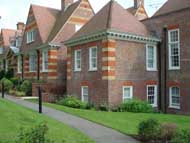
The former Hospital building in Roxeth Hill, now 'The Grange'.
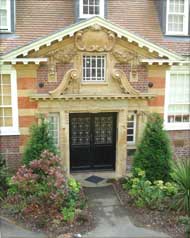
The former main entrance.
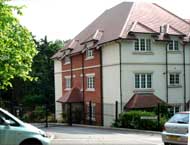
Entrance to Cottage Close.
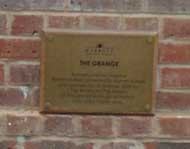

The 1906 foundation stone.
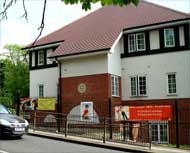
The Sydney Walton Nurses Home, now a YMCA hostel.
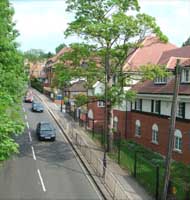
View of The Grange estate from the pedestrian bridge over Roxeth Hill.
A plaque installed by Barratt Homes, dedicated to 'The Grange'.
(Author unstated) 1917 List of the various hospitals treating military cases in the United Kingdom. London, H.M.S.O.
Walter D 1995 A Lookback at Harrow. Harrow, Orpheus Publications.
http://archiseek.com
http://harrow.gov.uk
https://harrowonline.org
https://historicengland.org.uk
https://player.bfi.org.uk
https://southharrowthenandnow.co.uk
www.british-history.ac.uk
www.iwm.org.uk
www.londongardensonline.org.uk
Return to home page